Capital Budgeting Analysis and Recommendation for CQU Printers Project
VerifiedAdded on 2020/05/28
|16
|2560
|62
Project
AI Summary
This project report presents a capital budgeting analysis for CQU Printers, evaluating two investment proposals: new printers A and B. The report calculates initial investments, operating cash inflows, and terminal cash flows for each project. It then determines relevant cash flow streams, payback periods, net present values (NPV), and internal rates of return (IRR) for both projects. A comparison of the projects is presented, including a graphical representation of NPV and IRR, leading to a recommendation based on both unlimited funds and capital rationing scenarios. The analysis concludes that Printer B is the better investment due to its higher NPV and IRR. The report includes references to support the findings and recommendations.
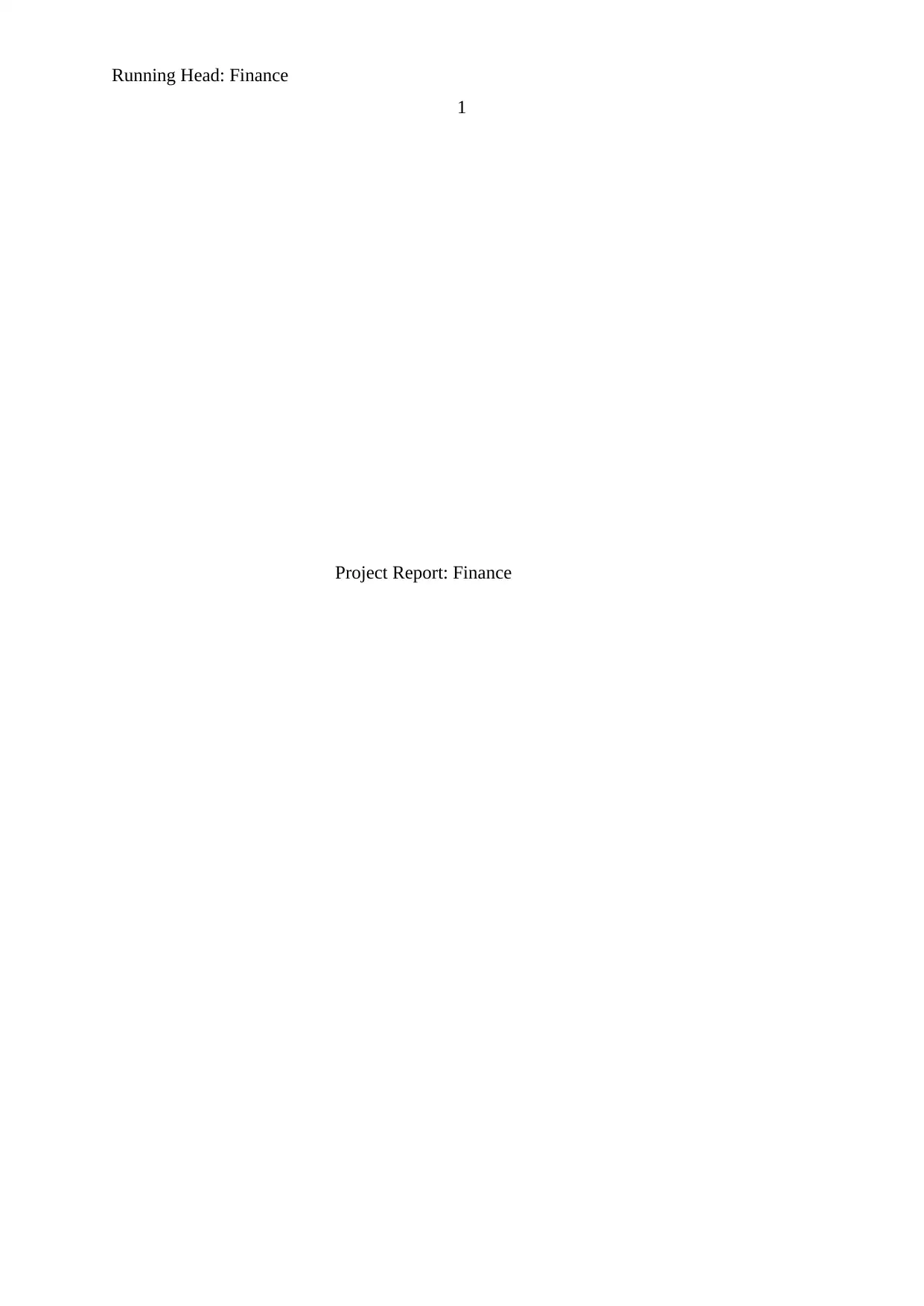
Running Head: Finance
1
Project Report: Finance
1
Project Report: Finance
Paraphrase This Document
Need a fresh take? Get an instant paraphrase of this document with our AI Paraphraser
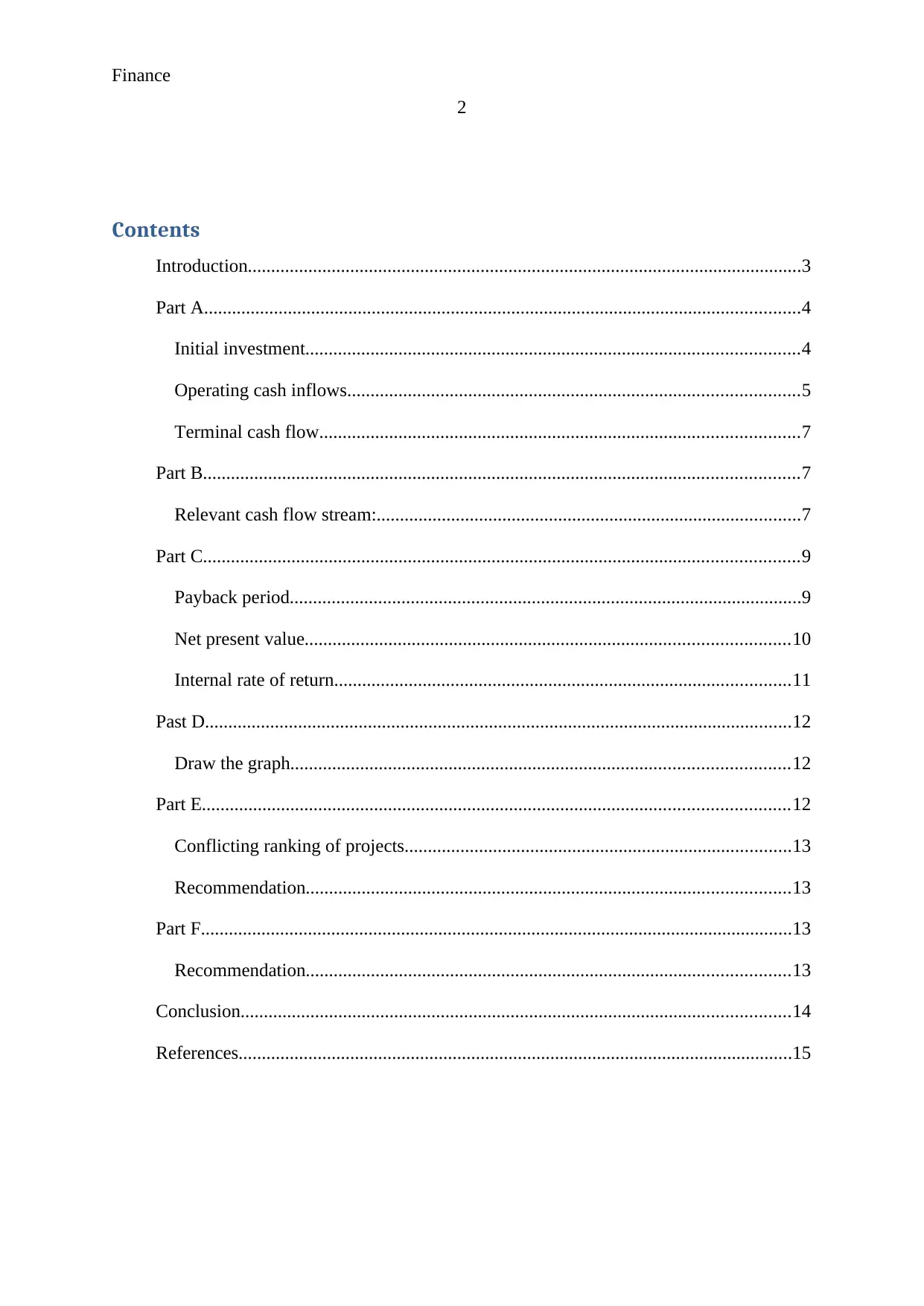
Finance
2
Contents
Introduction.......................................................................................................................3
Part A................................................................................................................................4
Initial investment..........................................................................................................4
Operating cash inflows.................................................................................................5
Terminal cash flow.......................................................................................................7
Part B................................................................................................................................7
Relevant cash flow stream:...........................................................................................7
Part C................................................................................................................................9
Payback period..............................................................................................................9
Net present value........................................................................................................10
Internal rate of return..................................................................................................11
Past D..............................................................................................................................12
Draw the graph...........................................................................................................12
Part E..............................................................................................................................12
Conflicting ranking of projects...................................................................................13
Recommendation........................................................................................................13
Part F...............................................................................................................................13
Recommendation........................................................................................................13
Conclusion......................................................................................................................14
References.......................................................................................................................15
2
Contents
Introduction.......................................................................................................................3
Part A................................................................................................................................4
Initial investment..........................................................................................................4
Operating cash inflows.................................................................................................5
Terminal cash flow.......................................................................................................7
Part B................................................................................................................................7
Relevant cash flow stream:...........................................................................................7
Part C................................................................................................................................9
Payback period..............................................................................................................9
Net present value........................................................................................................10
Internal rate of return..................................................................................................11
Past D..............................................................................................................................12
Draw the graph...........................................................................................................12
Part E..............................................................................................................................12
Conflicting ranking of projects...................................................................................13
Recommendation........................................................................................................13
Part F...............................................................................................................................13
Recommendation........................................................................................................13
Conclusion......................................................................................................................14
References.......................................................................................................................15
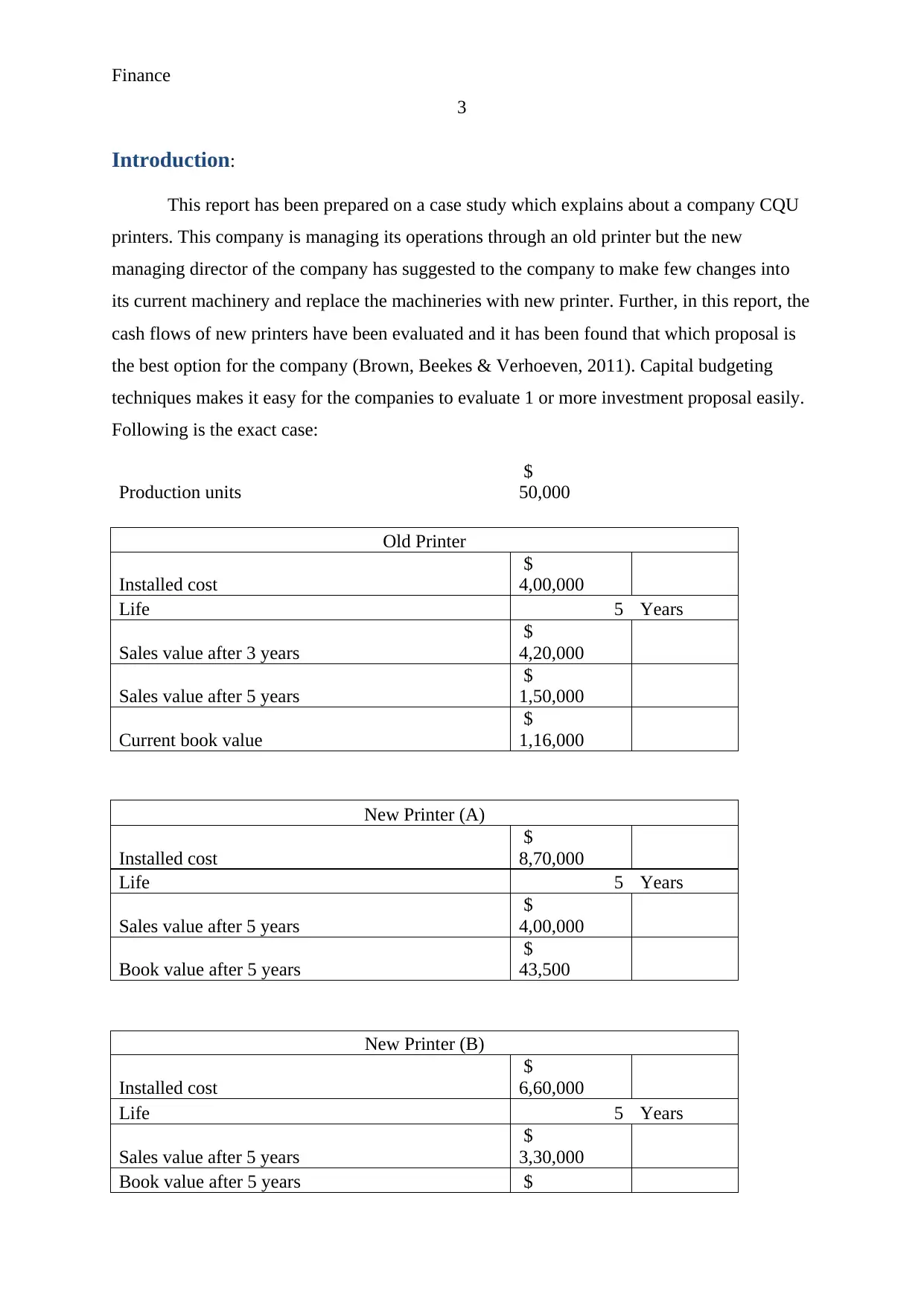
Finance
3
Introduction:
This report has been prepared on a case study which explains about a company CQU
printers. This company is managing its operations through an old printer but the new
managing director of the company has suggested to the company to make few changes into
its current machinery and replace the machineries with new printer. Further, in this report, the
cash flows of new printers have been evaluated and it has been found that which proposal is
the best option for the company (Brown, Beekes & Verhoeven, 2011). Capital budgeting
techniques makes it easy for the companies to evaluate 1 or more investment proposal easily.
Following is the exact case:
Production units
$
50,000
Old Printer
Installed cost
$
4,00,000
Life 5 Years
Sales value after 3 years
$
4,20,000
Sales value after 5 years
$
1,50,000
Current book value
$
1,16,000
New Printer (A)
Installed cost
$
8,70,000
Life 5 Years
Sales value after 5 years
$
4,00,000
Book value after 5 years
$
43,500
New Printer (B)
Installed cost
$
6,60,000
Life 5 Years
Sales value after 5 years
$
3,30,000
Book value after 5 years $
3
Introduction:
This report has been prepared on a case study which explains about a company CQU
printers. This company is managing its operations through an old printer but the new
managing director of the company has suggested to the company to make few changes into
its current machinery and replace the machineries with new printer. Further, in this report, the
cash flows of new printers have been evaluated and it has been found that which proposal is
the best option for the company (Brown, Beekes & Verhoeven, 2011). Capital budgeting
techniques makes it easy for the companies to evaluate 1 or more investment proposal easily.
Following is the exact case:
Production units
$
50,000
Old Printer
Installed cost
$
4,00,000
Life 5 Years
Sales value after 3 years
$
4,20,000
Sales value after 5 years
$
1,50,000
Current book value
$
1,16,000
New Printer (A)
Installed cost
$
8,70,000
Life 5 Years
Sales value after 5 years
$
4,00,000
Book value after 5 years
$
43,500
New Printer (B)
Installed cost
$
6,60,000
Life 5 Years
Sales value after 5 years
$
3,30,000
Book value after 5 years $
⊘ This is a preview!⊘
Do you want full access?
Subscribe today to unlock all pages.

Trusted by 1+ million students worldwide

Finance
4
33,000
Tax rate 30%
Cost of capital 14%
Profit before depreciation and taxes for CQU
printers
Year Old printer Printer A
Printer
B
1 120000 250000 210000
2 120000 270000 210000
3 120000 300000 210000
4 120000 330000 210000
5 120000 370000 210000
Part A:
In this part, the initial investment, operating cash inflows and terminal cash flows of
both the projects have been calculated:
Initial investment:
The below table explain that the initial investment of printer A is $ 4,50,000 and
initial investment of project B is $ 2,40,000 which explain that the investment of printer B is
quite lesser.
Calculation of initial investment
New Mach
(A)
New Mach
(B)
Installed cost $ 8,70,000 $ 6,60,000
Less: Selling
Price $ 4,20,000 $ 4,20,000
Initial
Investment $ 4,50,000 $ 2,40,000
(Atrill & McLaney, 2006)
W.N:
Calculation of current net profit
4
33,000
Tax rate 30%
Cost of capital 14%
Profit before depreciation and taxes for CQU
printers
Year Old printer Printer A
Printer
B
1 120000 250000 210000
2 120000 270000 210000
3 120000 300000 210000
4 120000 330000 210000
5 120000 370000 210000
Part A:
In this part, the initial investment, operating cash inflows and terminal cash flows of
both the projects have been calculated:
Initial investment:
The below table explain that the initial investment of printer A is $ 4,50,000 and
initial investment of project B is $ 2,40,000 which explain that the investment of printer B is
quite lesser.
Calculation of initial investment
New Mach
(A)
New Mach
(B)
Installed cost $ 8,70,000 $ 6,60,000
Less: Selling
Price $ 4,20,000 $ 4,20,000
Initial
Investment $ 4,50,000 $ 2,40,000
(Atrill & McLaney, 2006)
W.N:
Calculation of current net profit
Paraphrase This Document
Need a fresh take? Get an instant paraphrase of this document with our AI Paraphraser
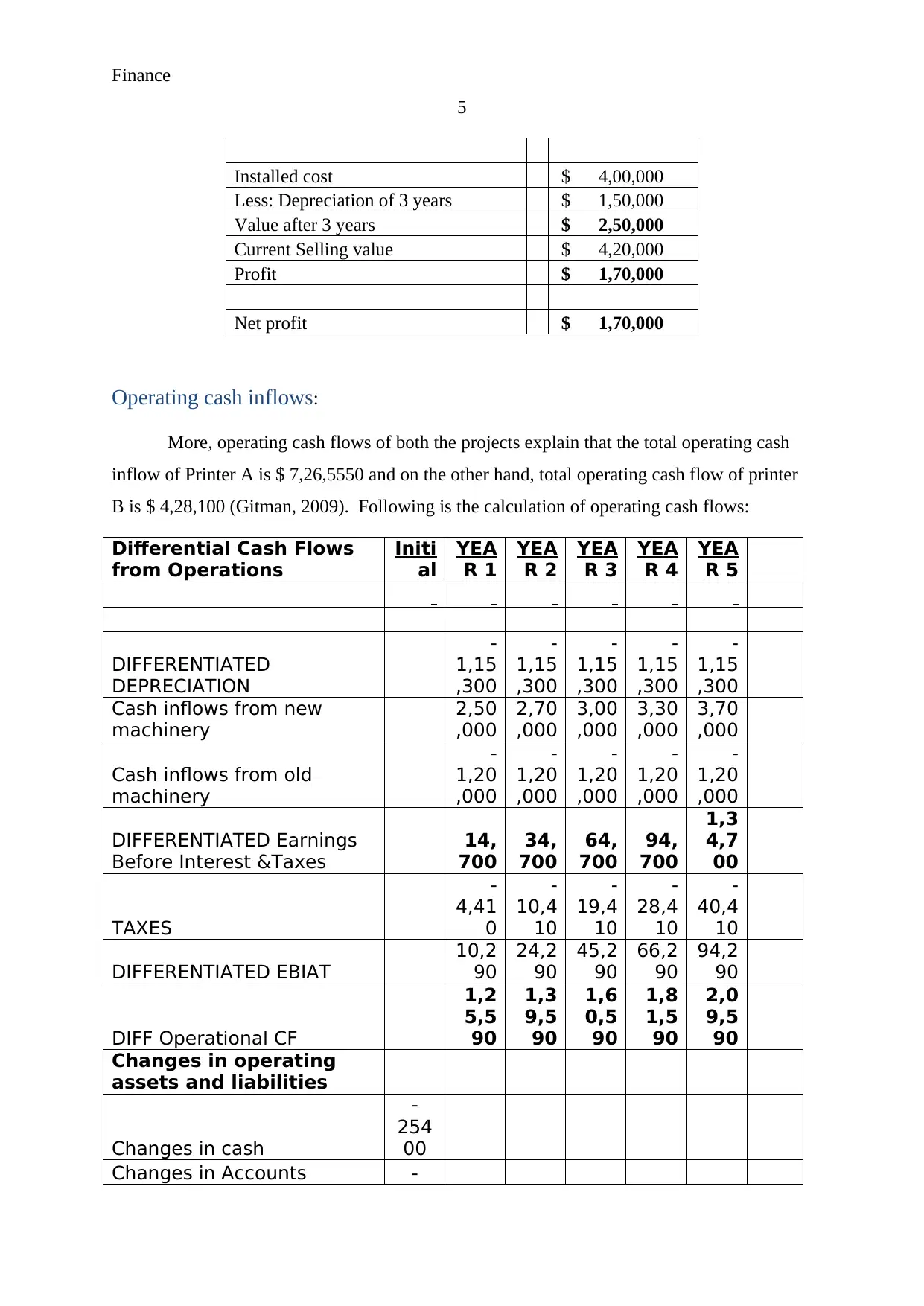
Finance
5
Installed cost $ 4,00,000
Less: Depreciation of 3 years $ 1,50,000
Value after 3 years $ 2,50,000
Current Selling value $ 4,20,000
Profit $ 1,70,000
Net profit $ 1,70,000
Operating cash inflows:
More, operating cash flows of both the projects explain that the total operating cash
inflow of Printer A is $ 7,26,5550 and on the other hand, total operating cash flow of printer
B is $ 4,28,100 (Gitman, 2009). Following is the calculation of operating cash flows:
Differential Cash Flows
from Operations
Initi
al
YEA
R 1
YEA
R 2
YEA
R 3
YEA
R 4
YEA
R 5
DIFFERENTIATED
DEPRECIATION
-
1,15
,300
-
1,15
,300
-
1,15
,300
-
1,15
,300
-
1,15
,300
Cash inflows from new
machinery
2,50
,000
2,70
,000
3,00
,000
3,30
,000
3,70
,000
Cash inflows from old
machinery
-
1,20
,000
-
1,20
,000
-
1,20
,000
-
1,20
,000
-
1,20
,000
DIFFERENTIATED Earnings
Before Interest &Taxes
14,
700
34,
700
64,
700
94,
700
1,3
4,7
00
TAXES
-
4,41
0
-
10,4
10
-
19,4
10
-
28,4
10
-
40,4
10
DIFFERENTIATED EBIAT
10,2
90
24,2
90
45,2
90
66,2
90
94,2
90
DIFF Operational CF
1,2
5,5
90
1,3
9,5
90
1,6
0,5
90
1,8
1,5
90
2,0
9,5
90
Changes in operating
assets and liabilities
Changes in cash
-
254
00
Changes in Accounts -
5
Installed cost $ 4,00,000
Less: Depreciation of 3 years $ 1,50,000
Value after 3 years $ 2,50,000
Current Selling value $ 4,20,000
Profit $ 1,70,000
Net profit $ 1,70,000
Operating cash inflows:
More, operating cash flows of both the projects explain that the total operating cash
inflow of Printer A is $ 7,26,5550 and on the other hand, total operating cash flow of printer
B is $ 4,28,100 (Gitman, 2009). Following is the calculation of operating cash flows:
Differential Cash Flows
from Operations
Initi
al
YEA
R 1
YEA
R 2
YEA
R 3
YEA
R 4
YEA
R 5
DIFFERENTIATED
DEPRECIATION
-
1,15
,300
-
1,15
,300
-
1,15
,300
-
1,15
,300
-
1,15
,300
Cash inflows from new
machinery
2,50
,000
2,70
,000
3,00
,000
3,30
,000
3,70
,000
Cash inflows from old
machinery
-
1,20
,000
-
1,20
,000
-
1,20
,000
-
1,20
,000
-
1,20
,000
DIFFERENTIATED Earnings
Before Interest &Taxes
14,
700
34,
700
64,
700
94,
700
1,3
4,7
00
TAXES
-
4,41
0
-
10,4
10
-
19,4
10
-
28,4
10
-
40,4
10
DIFFERENTIATED EBIAT
10,2
90
24,2
90
45,2
90
66,2
90
94,2
90
DIFF Operational CF
1,2
5,5
90
1,3
9,5
90
1,6
0,5
90
1,8
1,5
90
2,0
9,5
90
Changes in operating
assets and liabilities
Changes in cash
-
254
00
Changes in Accounts -
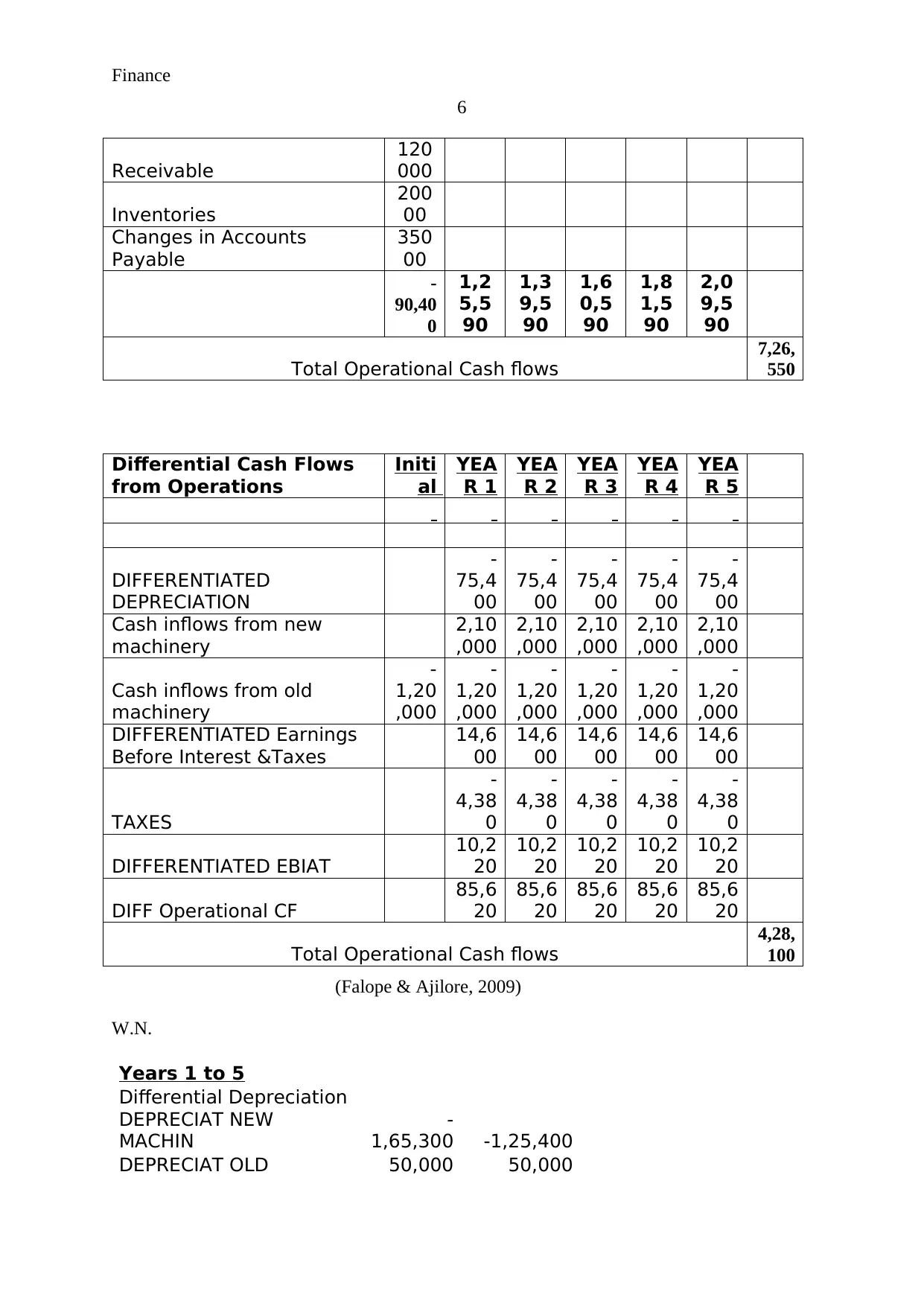
Finance
6
Receivable
120
000
Inventories
200
00
Changes in Accounts
Payable
350
00
-
90,40
0
1,2
5,5
90
1,3
9,5
90
1,6
0,5
90
1,8
1,5
90
2,0
9,5
90
Total Operational Cash flows
7,26,
550
Differential Cash Flows
from Operations
Initi
al
YEA
R 1
YEA
R 2
YEA
R 3
YEA
R 4
YEA
R 5
DIFFERENTIATED
DEPRECIATION
-
75,4
00
-
75,4
00
-
75,4
00
-
75,4
00
-
75,4
00
Cash inflows from new
machinery
2,10
,000
2,10
,000
2,10
,000
2,10
,000
2,10
,000
Cash inflows from old
machinery
-
1,20
,000
-
1,20
,000
-
1,20
,000
-
1,20
,000
-
1,20
,000
-
1,20
,000
DIFFERENTIATED Earnings
Before Interest &Taxes
14,6
00
14,6
00
14,6
00
14,6
00
14,6
00
TAXES
-
4,38
0
-
4,38
0
-
4,38
0
-
4,38
0
-
4,38
0
DIFFERENTIATED EBIAT
10,2
20
10,2
20
10,2
20
10,2
20
10,2
20
DIFF Operational CF
85,6
20
85,6
20
85,6
20
85,6
20
85,6
20
Total Operational Cash flows
4,28,
100
(Falope & Ajilore, 2009)
W.N.
Years 1 to 5
Differential Depreciation
DEPRECIAT NEW
MACHIN
-
1,65,300 -1,25,400
DEPRECIAT OLD 50,000 50,000
6
Receivable
120
000
Inventories
200
00
Changes in Accounts
Payable
350
00
-
90,40
0
1,2
5,5
90
1,3
9,5
90
1,6
0,5
90
1,8
1,5
90
2,0
9,5
90
Total Operational Cash flows
7,26,
550
Differential Cash Flows
from Operations
Initi
al
YEA
R 1
YEA
R 2
YEA
R 3
YEA
R 4
YEA
R 5
DIFFERENTIATED
DEPRECIATION
-
75,4
00
-
75,4
00
-
75,4
00
-
75,4
00
-
75,4
00
Cash inflows from new
machinery
2,10
,000
2,10
,000
2,10
,000
2,10
,000
2,10
,000
Cash inflows from old
machinery
-
1,20
,000
-
1,20
,000
-
1,20
,000
-
1,20
,000
-
1,20
,000
-
1,20
,000
DIFFERENTIATED Earnings
Before Interest &Taxes
14,6
00
14,6
00
14,6
00
14,6
00
14,6
00
TAXES
-
4,38
0
-
4,38
0
-
4,38
0
-
4,38
0
-
4,38
0
DIFFERENTIATED EBIAT
10,2
20
10,2
20
10,2
20
10,2
20
10,2
20
DIFF Operational CF
85,6
20
85,6
20
85,6
20
85,6
20
85,6
20
Total Operational Cash flows
4,28,
100
(Falope & Ajilore, 2009)
W.N.
Years 1 to 5
Differential Depreciation
DEPRECIAT NEW
MACHIN
-
1,65,300 -1,25,400
DEPRECIAT OLD 50,000 50,000
⊘ This is a preview!⊘
Do you want full access?
Subscribe today to unlock all pages.

Trusted by 1+ million students worldwide

Finance
7
MACHIN
Differential Depreciation
-
1,15,300 -75,400
Terminal cash flow:
More, terminal cash flows of both the projects explain that the total terminal cash
inflow of Printer A is $ 3,56,500 after the end of 5 years and on the other hand, total terminal
cash flow of printer B is $ 2,97,000. Following is the calculation of terminal cash flows:
Calculation of terminal cash flows
Printer A Printer B
Salvage
Value
$
43,500
$
33,000
Book Value
$
4,00,000
$
3,30,000
Capital Gain
$
3,56,500
$
2,97,000
Net cash
flow
$
3,56,500
$
2,97,000
Part B:
Relevant cash flow stream:
Accoridng to the part A, following is the cash flow stream of both the printers of the
company:
Cash Flows Stream
Initia
l
YEA
R 1
YEA
R 2
YEA
R 3
YEA
R 4
YEA
R 5
Initial Investment
-
4,50,
000
DIFFERENTIATED
DEPRECIATION
-
1153
00
-
1153
00
-
1153
00
-
1153
00
-
1153
00
7
MACHIN
Differential Depreciation
-
1,15,300 -75,400
Terminal cash flow:
More, terminal cash flows of both the projects explain that the total terminal cash
inflow of Printer A is $ 3,56,500 after the end of 5 years and on the other hand, total terminal
cash flow of printer B is $ 2,97,000. Following is the calculation of terminal cash flows:
Calculation of terminal cash flows
Printer A Printer B
Salvage
Value
$
43,500
$
33,000
Book Value
$
4,00,000
$
3,30,000
Capital Gain
$
3,56,500
$
2,97,000
Net cash
flow
$
3,56,500
$
2,97,000
Part B:
Relevant cash flow stream:
Accoridng to the part A, following is the cash flow stream of both the printers of the
company:
Cash Flows Stream
Initia
l
YEA
R 1
YEA
R 2
YEA
R 3
YEA
R 4
YEA
R 5
Initial Investment
-
4,50,
000
DIFFERENTIATED
DEPRECIATION
-
1153
00
-
1153
00
-
1153
00
-
1153
00
-
1153
00
Paraphrase This Document
Need a fresh take? Get an instant paraphrase of this document with our AI Paraphraser
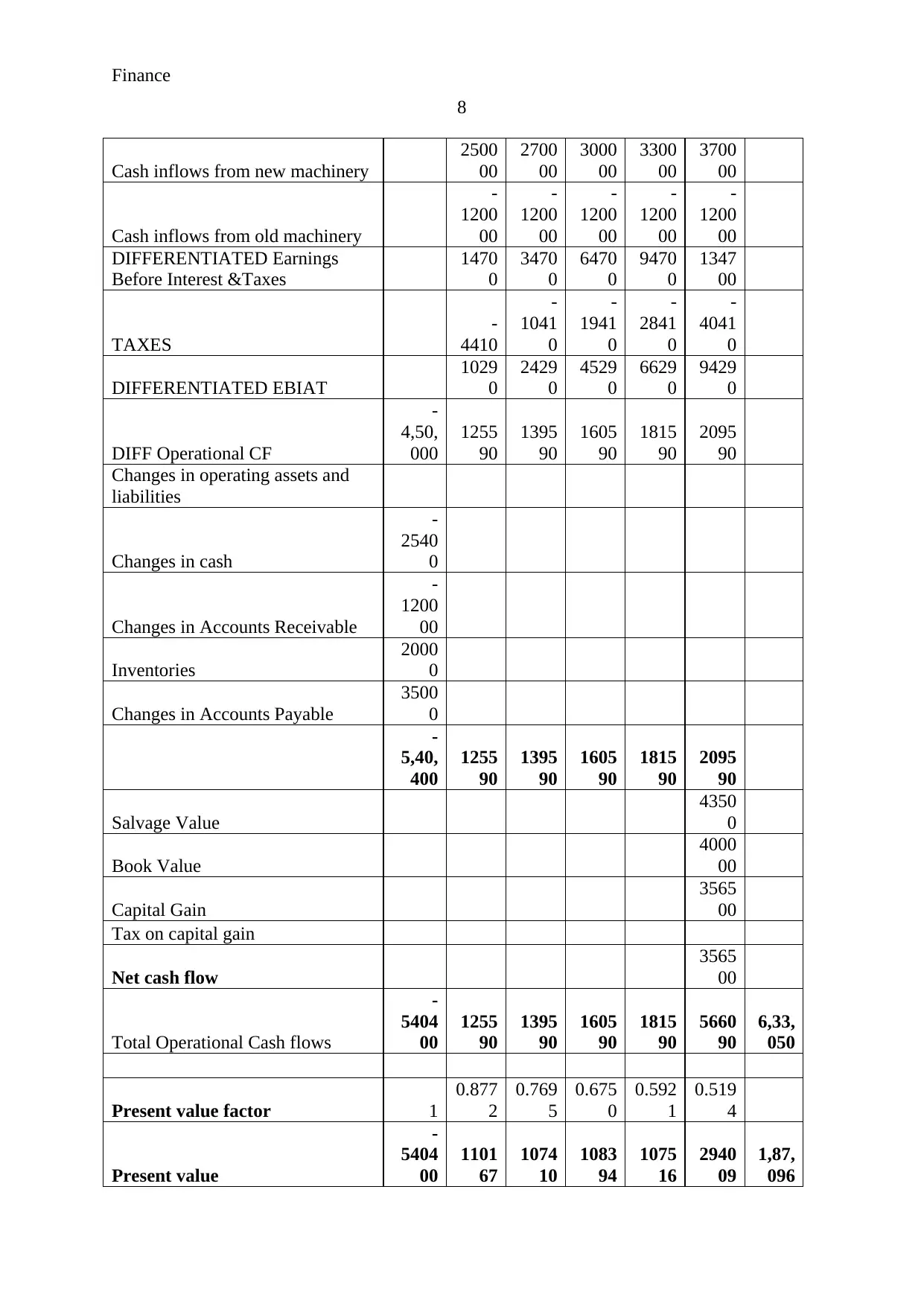
Finance
8
Cash inflows from new machinery
2500
00
2700
00
3000
00
3300
00
3700
00
Cash inflows from old machinery
-
1200
00
-
1200
00
-
1200
00
-
1200
00
-
1200
00
DIFFERENTIATED Earnings
Before Interest &Taxes
1470
0
3470
0
6470
0
9470
0
1347
00
TAXES
-
4410
-
1041
0
-
1941
0
-
2841
0
-
4041
0
DIFFERENTIATED EBIAT
1029
0
2429
0
4529
0
6629
0
9429
0
DIFF Operational CF
-
4,50,
000
1255
90
1395
90
1605
90
1815
90
2095
90
Changes in operating assets and
liabilities
Changes in cash
-
2540
0
Changes in Accounts Receivable
-
1200
00
Inventories
2000
0
Changes in Accounts Payable
3500
0
-
5,40,
400
1255
90
1395
90
1605
90
1815
90
2095
90
Salvage Value
4350
0
Book Value
4000
00
Capital Gain
3565
00
Tax on capital gain
Net cash flow
3565
00
Total Operational Cash flows
-
5404
00
1255
90
1395
90
1605
90
1815
90
5660
90
6,33,
050
Present value factor 1
0.877
2
0.769
5
0.675
0
0.592
1
0.519
4
Present value
-
5404
00
1101
67
1074
10
1083
94
1075
16
2940
09
1,87,
096
8
Cash inflows from new machinery
2500
00
2700
00
3000
00
3300
00
3700
00
Cash inflows from old machinery
-
1200
00
-
1200
00
-
1200
00
-
1200
00
-
1200
00
DIFFERENTIATED Earnings
Before Interest &Taxes
1470
0
3470
0
6470
0
9470
0
1347
00
TAXES
-
4410
-
1041
0
-
1941
0
-
2841
0
-
4041
0
DIFFERENTIATED EBIAT
1029
0
2429
0
4529
0
6629
0
9429
0
DIFF Operational CF
-
4,50,
000
1255
90
1395
90
1605
90
1815
90
2095
90
Changes in operating assets and
liabilities
Changes in cash
-
2540
0
Changes in Accounts Receivable
-
1200
00
Inventories
2000
0
Changes in Accounts Payable
3500
0
-
5,40,
400
1255
90
1395
90
1605
90
1815
90
2095
90
Salvage Value
4350
0
Book Value
4000
00
Capital Gain
3565
00
Tax on capital gain
Net cash flow
3565
00
Total Operational Cash flows
-
5404
00
1255
90
1395
90
1605
90
1815
90
5660
90
6,33,
050
Present value factor 1
0.877
2
0.769
5
0.675
0
0.592
1
0.519
4
Present value
-
5404
00
1101
67
1074
10
1083
94
1075
16
2940
09
1,87,
096

Finance
9
Cash Flows Stream
Initia
l
YEA
R 1
YEA
R 2
YEA
R 3
YEA
R 4
YEA
R 5
Initial Investment
-
2,40,
000
DIFFERENTIATED
DEPRECIATION
-
7540
0
-
7540
0
-
7540
0
-
7540
0
-
7540
0
Cash inflows from new machinery
2100
00
2100
00
2100
00
2100
00
2100
00
Cash inflows from old machinery
-
1200
00
-
1200
00
-
1200
00
-
1200
00
-
1200
00
-
1200
00
DIFFERENTIATED Earnings
Before Interest &Taxes
1460
0
1460
0
1460
0
1460
0
1460
0
TAXES
-
4380
-
4380
-
4380
-
4380 -4380
DIFFERENTIATED EBIAT
1022
0
1022
0
1022
0
1022
0
1022
0
DIFF Operational CF
-
2,40,
000
8562
0
8562
0
8562
0
8562
0
8562
0
Salvage Value
3300
0
Book Value
3300
00
Capital Gain
2970
00
Tax on capital gain
Net cash flow
2970
00
Total Operational Cash flows
-
2,40,
000
85,62
0
85,62
0
85,62
0
85,62
0
3,82,
620
4,85,
100
Present value factor 1
0.877
2
0.769
5
0.675
0
0.592
1
0.519
4
Present value
-
2400
00
7510
5.3
6588
1.8
5779
1.1
5069
3.9
1987
20.8
2,08,
193
(Arnold, 2008)
It explains that the cash flows stream of both the projects are $ 1,87,906 and $
2,08,193 (Davies & Crawford, 2011).
9
Cash Flows Stream
Initia
l
YEA
R 1
YEA
R 2
YEA
R 3
YEA
R 4
YEA
R 5
Initial Investment
-
2,40,
000
DIFFERENTIATED
DEPRECIATION
-
7540
0
-
7540
0
-
7540
0
-
7540
0
-
7540
0
Cash inflows from new machinery
2100
00
2100
00
2100
00
2100
00
2100
00
Cash inflows from old machinery
-
1200
00
-
1200
00
-
1200
00
-
1200
00
-
1200
00
-
1200
00
DIFFERENTIATED Earnings
Before Interest &Taxes
1460
0
1460
0
1460
0
1460
0
1460
0
TAXES
-
4380
-
4380
-
4380
-
4380 -4380
DIFFERENTIATED EBIAT
1022
0
1022
0
1022
0
1022
0
1022
0
DIFF Operational CF
-
2,40,
000
8562
0
8562
0
8562
0
8562
0
8562
0
Salvage Value
3300
0
Book Value
3300
00
Capital Gain
2970
00
Tax on capital gain
Net cash flow
2970
00
Total Operational Cash flows
-
2,40,
000
85,62
0
85,62
0
85,62
0
85,62
0
3,82,
620
4,85,
100
Present value factor 1
0.877
2
0.769
5
0.675
0
0.592
1
0.519
4
Present value
-
2400
00
7510
5.3
6588
1.8
5779
1.1
5069
3.9
1987
20.8
2,08,
193
(Arnold, 2008)
It explains that the cash flows stream of both the projects are $ 1,87,906 and $
2,08,193 (Davies & Crawford, 2011).
⊘ This is a preview!⊘
Do you want full access?
Subscribe today to unlock all pages.

Trusted by 1+ million students worldwide
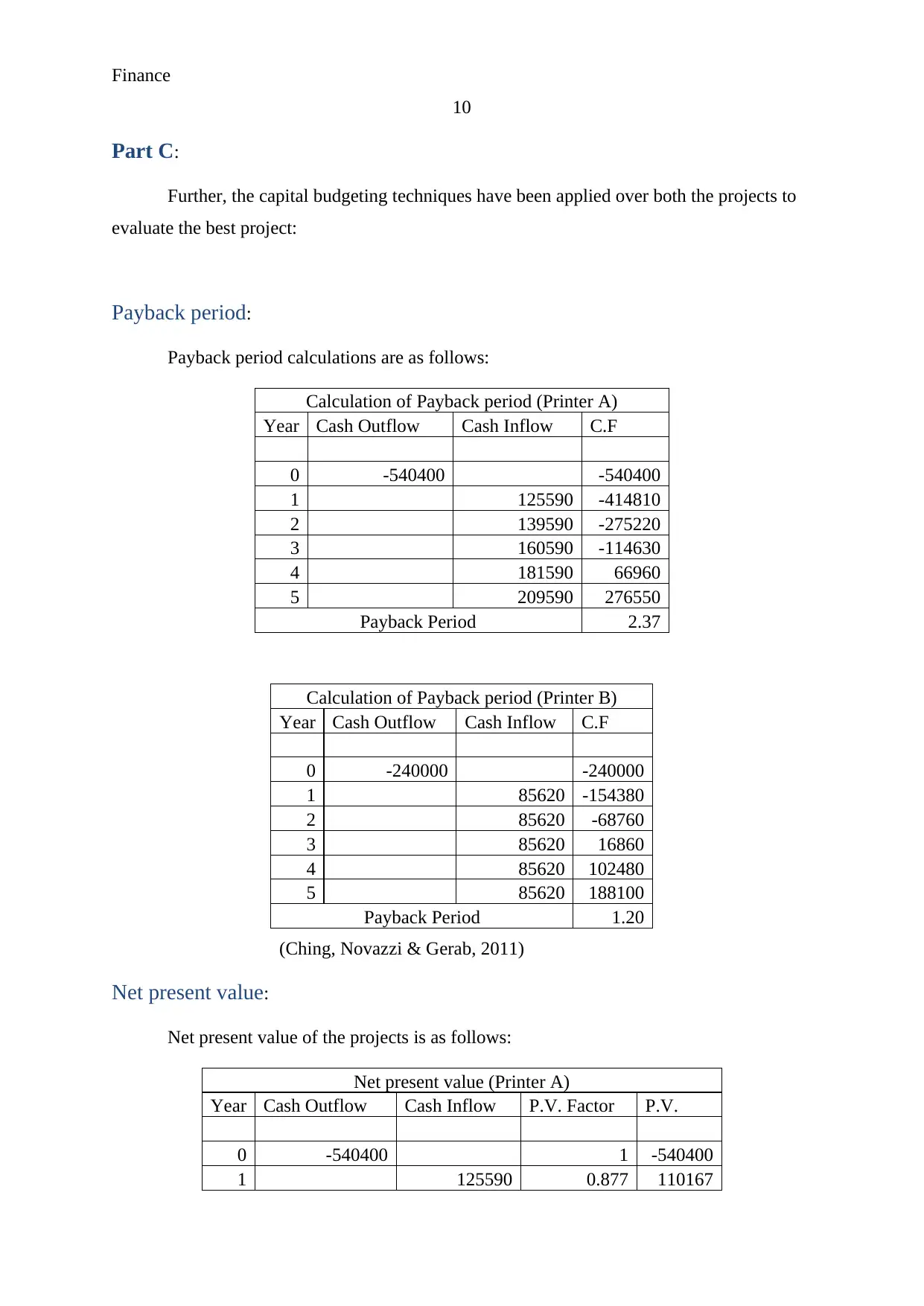
Finance
10
Part C:
Further, the capital budgeting techniques have been applied over both the projects to
evaluate the best project:
Payback period:
Payback period calculations are as follows:
Calculation of Payback period (Printer A)
Year Cash Outflow Cash Inflow C.F
0 -540400 -540400
1 125590 -414810
2 139590 -275220
3 160590 -114630
4 181590 66960
5 209590 276550
Payback Period 2.37
Calculation of Payback period (Printer B)
Year Cash Outflow Cash Inflow C.F
0 -240000 -240000
1 85620 -154380
2 85620 -68760
3 85620 16860
4 85620 102480
5 85620 188100
Payback Period 1.20
(Ching, Novazzi & Gerab, 2011)
Net present value:
Net present value of the projects is as follows:
Net present value (Printer A)
Year Cash Outflow Cash Inflow P.V. Factor P.V.
0 -540400 1 -540400
1 125590 0.877 110167
10
Part C:
Further, the capital budgeting techniques have been applied over both the projects to
evaluate the best project:
Payback period:
Payback period calculations are as follows:
Calculation of Payback period (Printer A)
Year Cash Outflow Cash Inflow C.F
0 -540400 -540400
1 125590 -414810
2 139590 -275220
3 160590 -114630
4 181590 66960
5 209590 276550
Payback Period 2.37
Calculation of Payback period (Printer B)
Year Cash Outflow Cash Inflow C.F
0 -240000 -240000
1 85620 -154380
2 85620 -68760
3 85620 16860
4 85620 102480
5 85620 188100
Payback Period 1.20
(Ching, Novazzi & Gerab, 2011)
Net present value:
Net present value of the projects is as follows:
Net present value (Printer A)
Year Cash Outflow Cash Inflow P.V. Factor P.V.
0 -540400 1 -540400
1 125590 0.877 110167
Paraphrase This Document
Need a fresh take? Get an instant paraphrase of this document with our AI Paraphraser
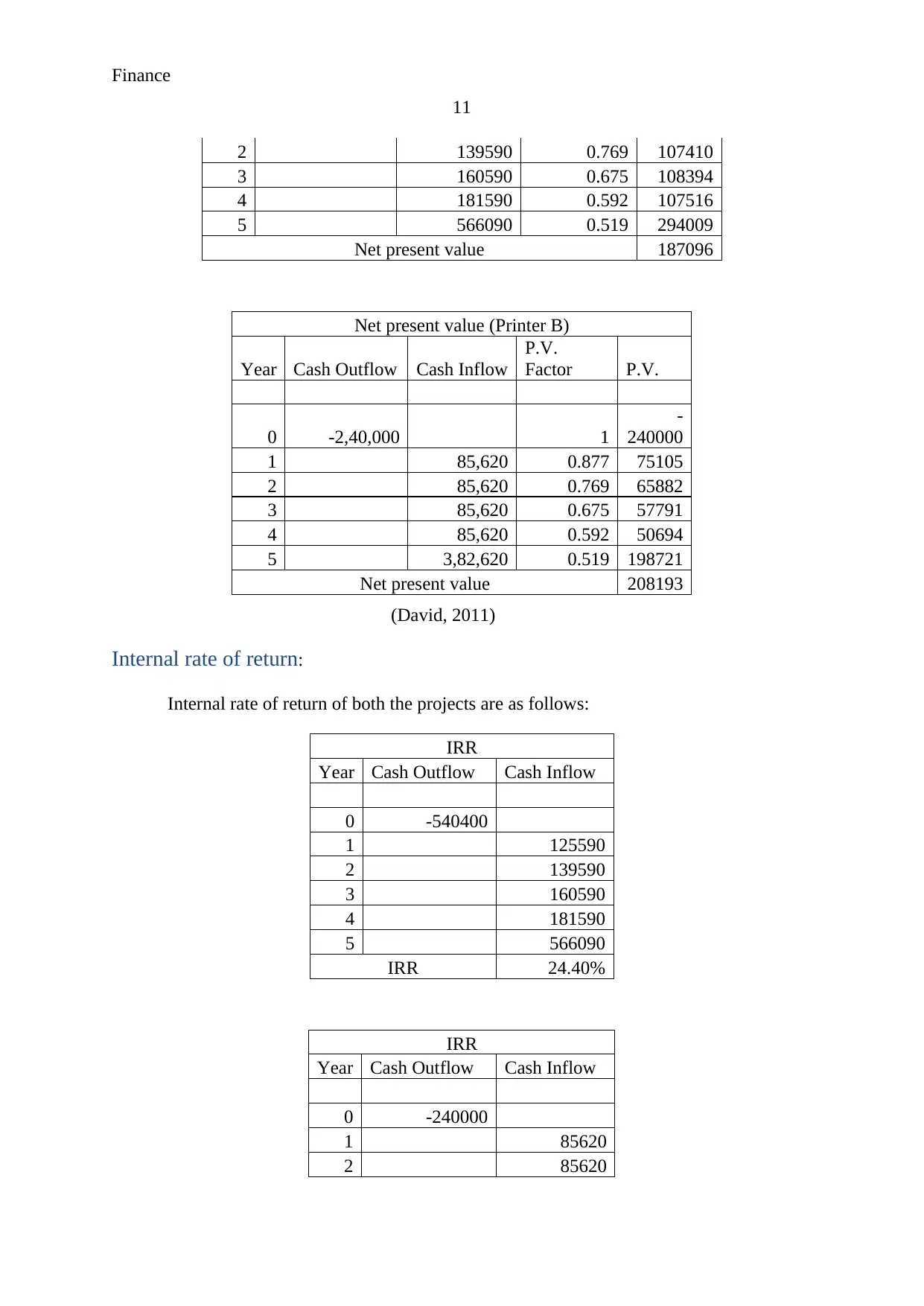
Finance
11
2 139590 0.769 107410
3 160590 0.675 108394
4 181590 0.592 107516
5 566090 0.519 294009
Net present value 187096
Net present value (Printer B)
Year Cash Outflow Cash Inflow
P.V.
Factor P.V.
0 -2,40,000 1
-
240000
1 85,620 0.877 75105
2 85,620 0.769 65882
3 85,620 0.675 57791
4 85,620 0.592 50694
5 3,82,620 0.519 198721
Net present value 208193
(David, 2011)
Internal rate of return:
Internal rate of return of both the projects are as follows:
IRR
Year Cash Outflow Cash Inflow
0 -540400
1 125590
2 139590
3 160590
4 181590
5 566090
IRR 24.40%
IRR
Year Cash Outflow Cash Inflow
0 -240000
1 85620
2 85620
11
2 139590 0.769 107410
3 160590 0.675 108394
4 181590 0.592 107516
5 566090 0.519 294009
Net present value 187096
Net present value (Printer B)
Year Cash Outflow Cash Inflow
P.V.
Factor P.V.
0 -2,40,000 1
-
240000
1 85,620 0.877 75105
2 85,620 0.769 65882
3 85,620 0.675 57791
4 85,620 0.592 50694
5 3,82,620 0.519 198721
Net present value 208193
(David, 2011)
Internal rate of return:
Internal rate of return of both the projects are as follows:
IRR
Year Cash Outflow Cash Inflow
0 -540400
1 125590
2 139590
3 160590
4 181590
5 566090
IRR 24.40%
IRR
Year Cash Outflow Cash Inflow
0 -240000
1 85620
2 85620
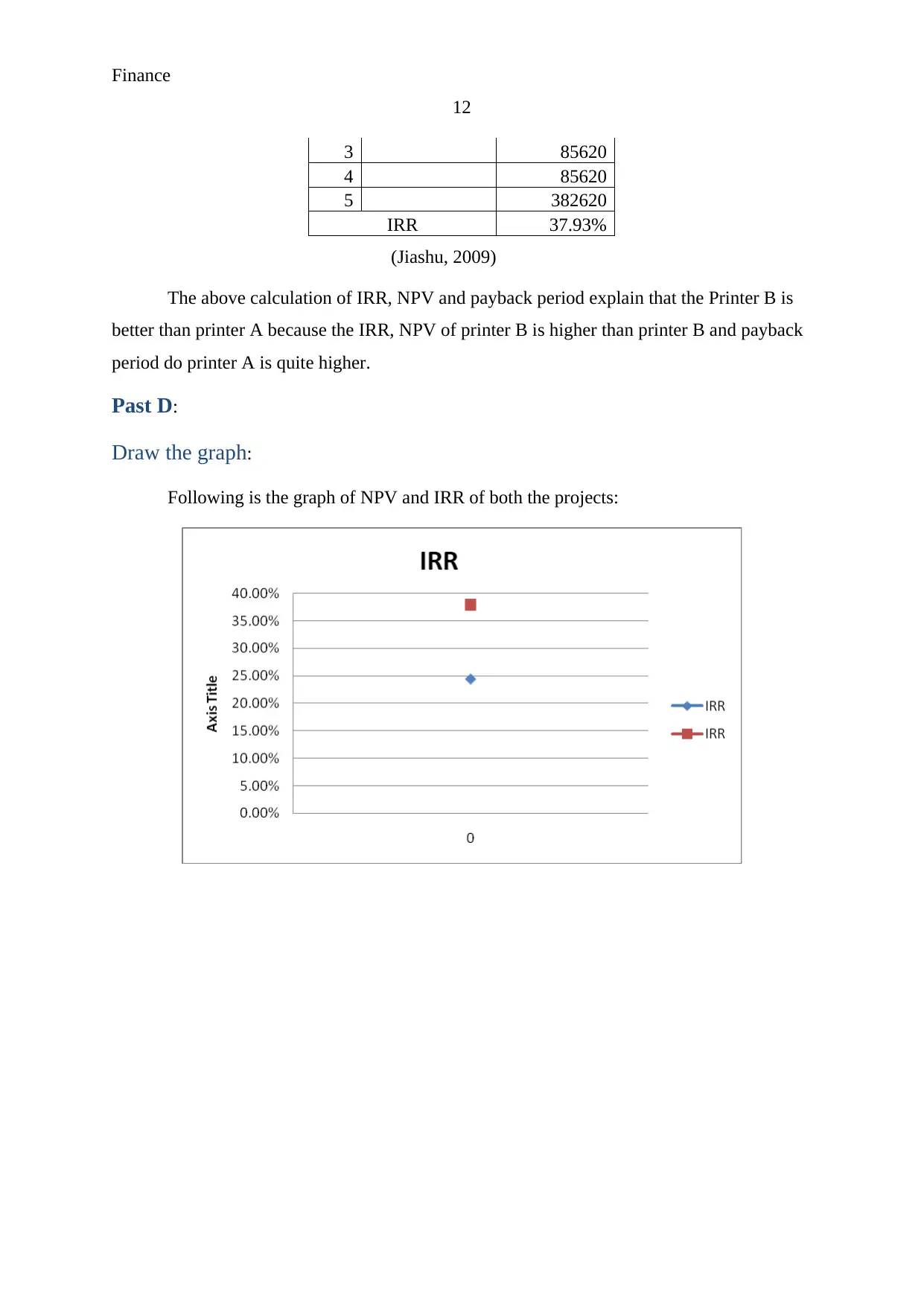
Finance
12
3 85620
4 85620
5 382620
IRR 37.93%
(Jiashu, 2009)
The above calculation of IRR, NPV and payback period explain that the Printer B is
better than printer A because the IRR, NPV of printer B is higher than printer B and payback
period do printer A is quite higher.
Past D:
Draw the graph:
Following is the graph of NPV and IRR of both the projects:
12
3 85620
4 85620
5 382620
IRR 37.93%
(Jiashu, 2009)
The above calculation of IRR, NPV and payback period explain that the Printer B is
better than printer A because the IRR, NPV of printer B is higher than printer B and payback
period do printer A is quite higher.
Past D:
Draw the graph:
Following is the graph of NPV and IRR of both the projects:
⊘ This is a preview!⊘
Do you want full access?
Subscribe today to unlock all pages.

Trusted by 1+ million students worldwide
1 out of 16
Related Documents
Your All-in-One AI-Powered Toolkit for Academic Success.
+13062052269
info@desklib.com
Available 24*7 on WhatsApp / Email
![[object Object]](/_next/static/media/star-bottom.7253800d.svg)
Unlock your academic potential
Copyright © 2020–2025 A2Z Services. All Rights Reserved. Developed and managed by ZUCOL.





